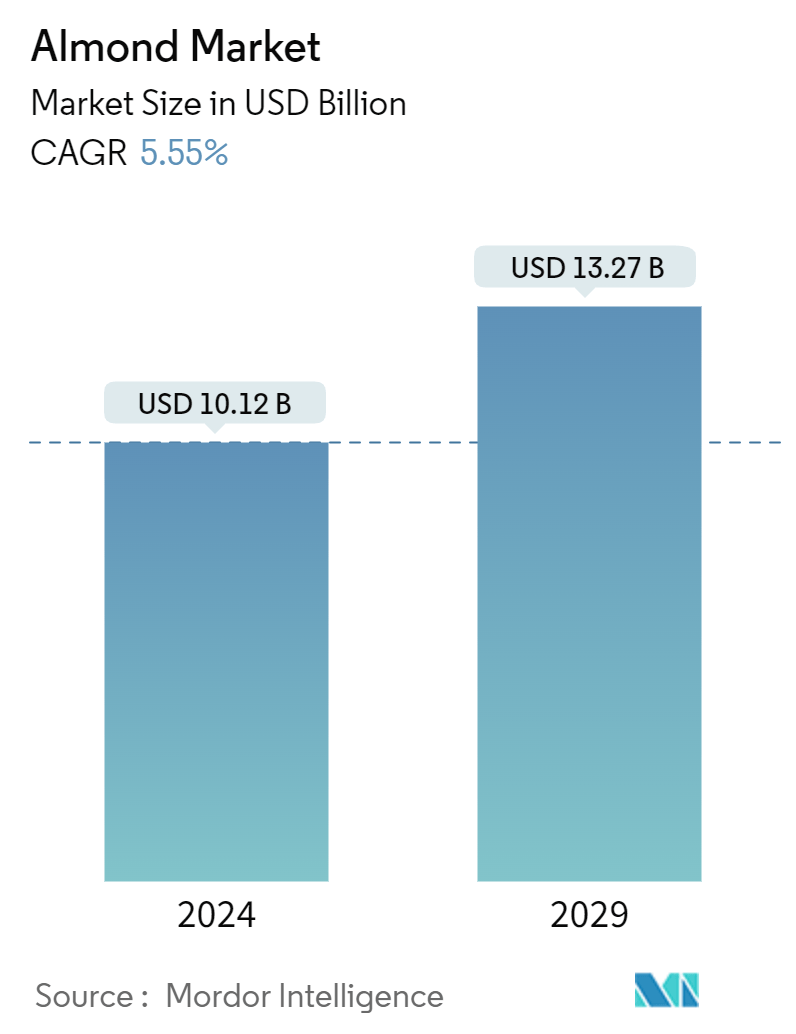Market Size of Almond Industry

| Study Period | 2019 - 2029 |
| Market Size (2024) | USD 10.12 Billion |
| Market Size (2029) | USD 13.27 Billion |
| CAGR (2024 - 2029) | 5.55 % |
| Fastest Growing Market | Asia-Pacific |
| Largest Market | North America |
Major Players*Disclaimer: Major Players sorted in no particular order |
Almond Market Analysis
The Almond Market size is estimated at USD 10.12 billion in 2024, and is expected to reach USD 13.27 billion by 2029, growing at a CAGR of 5.55% during the forecast period (2024-2029).
Almonds are used as ingredients in manufactured goods, including cereal and granola bars, as snacks, in in-home baking, and at food service outlets. The growing popularity of almonds is partly attributed to the rise of plant-based milk, such as almond milk. Almond milk is considered the healthier alternative to regular milk, especially for the lactose-intolerant population, offering consumers a low-fat, high-protein option. Almond milk has become a staple for many supermarkets and coffee shops.
Additionally, the growing veganism worldwide is supplementing the market's growth. For instance, according to a survey conducted by ProVeg International, the vegan share in Belgium increased from 2% in 2020 to 3% in 2022. The rise in veganism is supporting the market growth. Furthermore, according to the Food and Agriculture Organization (FAO), the United States is the primary producer of almonds, followed by Spain, Iran, and Australia. The favorable climate with fertile soil and abundant sunshine and the required equipment to be used during growth and harvesting favors the enhanced production of almonds in these regions.
Besides, new branded products and innovative uses of almonds in ice cream, confectioneries, and baked goods have been introduced. For instance, in 2023, Blue Diamond Growers launched a new product called Thin Dipped Almonds, which is available in two flavors, namely double dark chocolate and dark chocolate sea salt caramel. It is cholesterol-free, high in vitamin E, and contains no artificial flavors or colors. In addition, nut flour is expanding as an alternative to regular wheat flour in the gluten-free market, increasing the potential for market growth during the study period.
Almond Industry Segmentation
The edible part of the almond is a seed from a drupe, a fruit in which the outer shell and hull layers are typically not eaten. After extracting the almond seed, the shells and hulls are often used for livestock feed and bedding. For report purposes, the analysis of "Other Nuts, Fresh Or Dried, Whether Or Not shelled or peeled - almonds" (HS code 0802) is considered. The almond market includes production analysis (volume), consumption analysis (value and volume), export analysis (value and volume), import analysis (value and volume), and price trend analysis. The market is geographically segmented into North America, Europe, Asia-Pacific, South America, and the Middle East and Africa. The report offers the market size and forecast based on volume (metric tons) and value (USD) for all the above-mentioned segments.
| Geography | ||||||||
| ||||||||
| ||||||||
| ||||||||
| ||||||||
|
Almond Market Size Summary
The almond market is experiencing significant growth, driven by its increasing use as a key ingredient in various food products and its rising popularity as a healthy snack option. Almonds are integral to the production of plant-based milk, particularly almond milk, which is favored for its health benefits, especially among lactose-intolerant consumers. The market is further bolstered by innovative product launches, such as Blue Diamond Growers' Thin Dipped Almonds, and the expanding use of almond flour in gluten-free products. The demand for almonds is also fueled by the growing consumer preference for nutritious snacks, with almonds being linked to reduced cardiovascular risks. This trend is supported by manufacturers introducing health-oriented almond-based products, catering to health-conscious and vegan consumers.
North America, particularly the United States, dominates the almond market due to its extensive production and consumption. The favorable climatic conditions and advanced agricultural practices in the U.S. contribute to its leading position in almond production. The market benefits from the increasing consumer interest in international cuisines and the innovative use of almonds in gourmet cooking. The rise of the vegan population and the demand for gluten-free and non-dairy products further enhance the market's growth prospects. Initiatives by companies like Blue Diamond to explore the health benefits of almonds and the introduction of new flavors and products are expected to sustain the market's expansion in the coming years.
Almond Market Size - Table of Contents
-
1. MARKET DYNAMICS
-
1.1 Market Overview
-
1.2 Market Drivers
-
1.2.1 Rise in Percentage of Area Harvested Under Almond Cultivation
-
1.2.2 Demand for Healthy Snacking Options
-
-
1.3 Market Restraints
-
1.3.1 Water Scarcity in Almond Producing Regions
-
1.3.2 Drop in the Prices of Almonds
-
-
1.4 Supply Chain/Value Chain Analysis
-
-
2. MARKET SEGMENTATION Production Analysis (Volume), Consumption Analysis (Value and Volume), Export Analysis (Value and Volume), Import Analysis (Value and Volume), and Price Trend Analysis.
-
2.1 Geography
-
2.1.1 North America
-
2.1.1.1 United States
-
-
2.1.2 Europe
-
2.1.2.1 Spain
-
2.1.2.2 Italy
-
2.1.2.3 Portugal
-
2.1.2.4 Greece
-
-
2.1.3 Asia-Pacific
-
2.1.3.1 Iran
-
2.1.3.2 Turkey
-
2.1.3.3 Australia
-
2.1.3.4 China
-
2.1.3.5 India
-
2.1.3.6 Vietnam
-
-
2.1.4 South America
-
2.1.4.1 Chile
-
2.1.4.2 Argentina
-
-
2.1.5 Middle-East and Africa
-
2.1.5.1 Morocco
-
2.1.5.2 Tunisia
-
2.1.5.3 Saudi Arabia
-
2.1.5.4 Egypt
-
-
-
Almond Market Size FAQs
How big is the Almond Market?
The Almond Market size is expected to reach USD 10.12 billion in 2024 and grow at a CAGR of 5.55% to reach USD 13.27 billion by 2029.
What is the current Almond Market size?
In 2024, the Almond Market size is expected to reach USD 10.12 billion.

